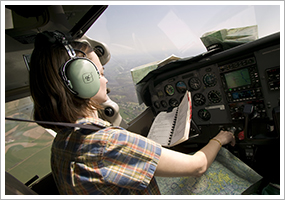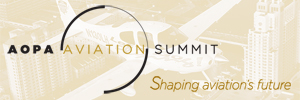| ||||
| | FT News | Inside AOPA | TRAINING PRODUCTS | FINAL EXAM | |||
TRAINING TIPsFlying ‘hands off’ The Oct. 9 “Training Tip” described the link between a properly located center of gravity (CG) and an aircraft’s longitudinal stability. It made the point that an aircraft’s stability allows it to be trimmed so that it will maintain straight-and-level flight with hands off the controls. Do you seek hands-off flight as a matter of course? Knowing that you can trust your aircraft to maintain airspeed and altitude without a lot of needless waggling and retrimming demonstrates that you are applying basic aerodynamic principles to aircraft control. Equally important, establishing hands-off flight reduces pilot workload, enabling you to divide your attention between other tasks such as communication and navigation. And that’s a practical test requirement! The airplane will work with you—and realizing that is one of the wonderful early insights that make order out of sensory chaos. “Think back to those first few flight lessons. Striving mightily to learn a fundamental skill such as straight-and-level flight, most student pilots first commit the common errors of fixation, forgetfulness, and faintheartedness. They’re overwhelmed by the workload; the airplane is flying them. This quickly changes for the better. The student learns to trust the airplane to be predictable, not predatory. That insight instills confidence, which allows the student to divide attention between tasks such as setting airspeed, maintaining altitude, and holding a heading,” Dan Namowitz wrote in the September 2008 AOPA Flight Training feature “ Short and Soft: Sometimes you have to combine your skills.” Be patient with your aircraft. Overcontrolling is at the root of much imprecision. “If the trimming process occurs too quickly—which students tend to do—it becomes a difficult task. When trimming, wait a moment or two for airspeed and power to stabilize before you fine-trim the elevator. After that adjustment, again wait for a moment or two and reevaluate the need for additional pitch trim,” Ralph Butcher wrote in “ Insights: Confidence maneuvers.” Also, “Relax!” That word was the title of the Dec. 22, 2006, “Training Tip,” which reminded pilots, “Teaching yourself to relax while flying is more than just psychologically comforting—it makes you fly better.” YOUR PARTNER IN TRAININGOne of your tasks in preparing for any airborne journey is to become familiar with all available information concerning your flight. How long are the runways at your intended destination, and can your aircraft safely take off from and land within those lengths? What are the communication and weather frequencies? AOPA’s Airport Directory Online has the answers to these questions and more. The directory features vital details on more than 5,300 public-use landing facilities, 7,000 fixed-base operators and aviation-related businesses, and more than 55,000 restaurants, hotels, and transportation services. Toll-free flight service station (FSS) telephone numbers are listed for more than 5,000 public-use airports so that you can call the individual FSS instead of following the prompts through 800/WX-BRIEF.
Did you know that student pilots who join AOPA are three times more likely to complete their flight training? Membership includes unlimited access to aviation information by phone (800/USA-AOPA, weekdays from 8:30 a.m. to 6 p.m. Eastern time) or from AOPA Flight Training Online or AOPA Online. If you’re not already a member, join today and get the pilot’s edge. Login information is available online. FLIGHT TRAINING NEWSEmbry-Riddle buys Waco that was part of its historyEmbry-Riddle Aeronautical University recently welcomed back one of its own: a 1928 Waco biplane that had once belonged to one of the university’s founders. An Indiantown, Fla., man refurbished and sold the Waco to the university for more than $50,000, according to a report in TCPalm.com. The biplane, which still has its original N number and logo, will appear at airshows and other venues, but it won’t be used for training because the forward seat does not have a full set of controls. Former students are new ownersThree former students of a New York flight school returned to the school in August as its owners. Don Scoca, Don Vogel, and Doug Wohl earned their certificates at Nassau Flyers at Republic Airport in East Farmingdale six years ago, but they did not get to know each other until they began training for their instrument ratings. They eventually bought an airplane together, and this year came together to purchase the flight school. Read more >> Helicopter degree offered at San Juan CollegeSan Juan College will begin offering helicopter flight training in partnership with Enchantment Helicopters of Albuquerque, N.M., beginning in January 2010. The program will be an associate of applied science degree in helicopter technology and will cover four semesters. Graduates of the program will have logged 200 hours in rotary-wing aircraft and will have obtained private, commercial, and flight instructor certificates. Read more >> N.C. flight school adds Redbird simulatorBurlington Aviation at Burlington-Alamance Regional Airport in North Carolina has added a Redbird FMX flight simulator to its training fleet. The FMX offers wrap-around visuals, a fully enclosed cockpit, and a full-motion platform. Burlington’s aircraft fleet includes five Cessna 172s, a Cessna 152, a Piper Seneca, and a Piper Arrow. Inside AOPAHead in the clouds? Course addresses low ceiling, visibilityLow ceilings and visibilities rank as the greatest weather hazard to pilots. Thunderstorms, icing, high winds, turbulence—none of these more dramatic, higher-profile threats comes close to killing as many pilots as simple, condensed water vapor. Learn how to minimize the risk these conditions pose in the AOPA Air Safety Foundation free online course Weather Wise: Ceiling and Visibility. The course, which takes about 45 to 60 minutes to complete, gives you the tools you need to prepare for changing weather and to cope with two of the most challenging weather phenomena known to pilots. AOPA retires eDirectory for PC, Palm OSOn Oct. 22, AOPA will retire its Airport eDirectory application for PC and Palm operating systems. Discontinuation of the Airport eDirectory will not affect AOPA’s Airport Directory Online or any of the AOPA Airports mobile applications. The eDirectory, which debuted in 2001, is limited to serving older versions of Microsoft Windows and Palm operating systems. The decision to discontinue the eDirectory followed an examination of member usage over the last two years. The ongoing maintenance costs were disproportionate to the Airport eDirectory’s declining user base. AOPA will continue to develop its flight planning products, which include AOPA’s Airport Directory Online, AOPA Internet Flight Planner, and aviation weather.
TRAINING PRODUCTSKing Schools updates ‘Flying the Garmin G1000’King Schools Inc. has released Version 8 of its Cleared for Flying the Garmin G1000 course. The updated course now includes autopilot and WAAS functions, and discusses improvements made to the "flight plan" and "direct to" windows, the primary flight display status bar, and the way navigation modes are displayed on the HSI, among others. The course is designed to be used on a personal computer and sells for $249. Order online or call 800/854-1001.
Note: Products listed have not been evaluated by ePilot editors unless otherwise noted. AOPA assumes no responsibility for products or services listed or for claims or actions by manufacturers or vendors. FINAL EXAMQuestion: I am considering forming a flying club. What resources does AOPA have to help me with this process?
Answer: A flying club is a great way to reduce the individual expense of aircraft ownership. AOPA has an online section full of flying club information. You’ll find tips on organizing and managing the club, suggestions on purchasing club aircraft, and help with calculating operating costs, taxes, and insurance. AOPA’s Tips on Buying Used Aircraft can help you through the purchasing process; other AOPA membership services can help with financing, insurance, and legal advice. Got a question for our technical services staff? E-mail [email protected] or call the Pilot Information Center, 800/872-2672. Don’t forget the online archive of "Final Exam" questions and answers, searchable by keyword or topic. WHAT’S NEW ONLINEWould you like to fly in a beautiful balloon? AOPA Flight Training Technical Editor Mike Collins was in Albuquerque, N.M., last week to photograph some of the more than 500 hot air balloons that filled the skies for the Thirty-eighth Annual Albuquerque Balloon Fiesta. Read a report and see a slide show on AOPA Online >> Picture Perfect
AVIATION EVENTS & WEATHER To submit an event or to search all events in the calendar, visit AOPA Online. For airport details, including FBO fuel prices, see AOPA’s Airport Directory Online. Flight Instructor Refresher ClinicsThe next AOPA Air Safety Foundation Flight Instructor Refresher Clinics are scheduled in Columbia, S.C., Oct. 17 and 18; Windsor, Conn., Fort Lauderdale, Fla., and Indianapolis, Ind., Oct. 24 and 25; San Diego, Calif., Atlanta, Ga., and Austin, Texas, Nov. 14 and 15; Anchorage, Alaska, Albuquerque, N.M., and Reston, Va., Nov. 21 and 22. For a complete schedule, see AOPA Online.
Can’t make it in person? Sign up for the CFI Refresher Online. AOPA Air Safety Foundation Safety SeminarsAOPA Air Safety Foundation Safety Seminars are scheduled in Fairbanks, Alaska, Oct. 16 and 17; Eugene, Ore., Oct. 19; Portland, Ore., Oct. 20; Seattle, Wash., Oct. 21; Palmdale, Calif., Oct. 26; San Luis Obispo, Calif., and Lynchburg, Va., Oct. 27; Fresno, Calif., Oct. 28; and Concord, Calif., Oct. 29. Topics vary—for details and a complete schedule, see AOPA Online. | Got news? Contact ePilot. Having difficulty using this service? Visit the ePilot Frequently Asked Questions now at AOPA Online or write to [email protected]. |
| Member Tools : Send feedback | Update member profile | Change email address | Unsubscribe | ePilot Archive Editorial Team : ePilot Flight Training Editor : Jill Tallman | ePilot Editor: Sarah Brown | Contributor: Alton Marsh |






